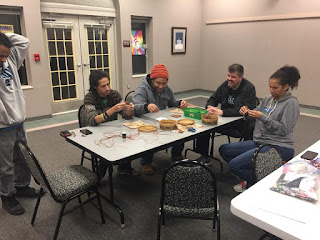#Culture Heals Basket Weaving Class
 These culture classes are a positive thing for our communities and especially our youth! please come out and bring a friend! the classes continue to grow every month and its a blessing! These monthly culture classes are times for us to celebrate and fellowship who we are and learn our ways! It is good medicine and it's helping a lot of our people to be involved in something positive! Last night we discussed that the rivers are our life blood and provide us sustenance. Basketry was used for nearly every aspect of life and for events justifying a ceremony, e.g. a baby being born, the first spring salmon, a young girl’s Flower Dance (a rite of passage ceremony when a girl reaches puberty), gathering of acorns, the acorn ceremony, Brush Dance, White Deerskin Dance (a world renewal ceremony), Jump Dance, and more. Basketry was used to prepare and contain food; carry wood and other heavy loads; collect seeds and berries; trap fish, eels, birds and small animals; carry babies; and for the traditional ceremonies.Basketry can be classified into four types: Coiled basketry using grasses and rushes, Plaiting basketry using materials that are wide and ribbon-like, such as palms, yucca or New Zealand flax, Twining basketry using materials from roots and tree bark. Twining actually refers to a weaving technique where two or more flexible weaving elements ("weavers") cross each other as they weave through the stiffer radial spokes and Wicker and/or Splint basketry using reed, cane, willow, oak, and ash.
These culture classes are a positive thing for our communities and especially our youth! please come out and bring a friend! the classes continue to grow every month and its a blessing! These monthly culture classes are times for us to celebrate and fellowship who we are and learn our ways! It is good medicine and it's helping a lot of our people to be involved in something positive! Last night we discussed that the rivers are our life blood and provide us sustenance. Basketry was used for nearly every aspect of life and for events justifying a ceremony, e.g. a baby being born, the first spring salmon, a young girl’s Flower Dance (a rite of passage ceremony when a girl reaches puberty), gathering of acorns, the acorn ceremony, Brush Dance, White Deerskin Dance (a world renewal ceremony), Jump Dance, and more. Basketry was used to prepare and contain food; carry wood and other heavy loads; collect seeds and berries; trap fish, eels, birds and small animals; carry babies; and for the traditional ceremonies.Basketry can be classified into four types: Coiled basketry using grasses and rushes, Plaiting basketry using materials that are wide and ribbon-like, such as palms, yucca or New Zealand flax, Twining basketry using materials from roots and tree bark. Twining actually refers to a weaving technique where two or more flexible weaving elements ("weavers") cross each other as they weave through the stiffer radial spokes and Wicker and/or Splint basketry using reed, cane, willow, oak, and ash. 
Today, we still use the same types of the baskets that our ancestors used. However, with the introduction of modern amenities like pots and pans we mostly use the cooking baskets during the ceremonial dances.



Comments
Post a Comment